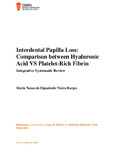| dc.contributor.advisor | JARANA, PAULA LOPEZ | |
| dc.contributor.author | Borges, Maria Nunes de Figueiredo Vieira | |
| dc.date.accessioned | 2023-11-23T10:21:59Z | |
| dc.date.available | 2023-11-23T10:21:59Z | |
| dc.date.issued | 2023 | |
| dc.identifier.uri | http://hdl.handle.net/20.500.11816/4412 | |
| dc.description.abstract | Introduction: nowadays, the absence of the interdental papilla leads to an aesthetic discomfort and affects self-esteem in some patients. It can lead to caries lesions and phonetic alterations. Thus, dentists have developed surgical and non-surgical techniques to treat this loss of papilla.
Objective: is to know which is the best non-surgical technique, between Hyaluronic Acid and Platelet-Rich Fibrin, that restores the deficient interdental papilla.
Materials and Methods: we used several databases, such as Pubmed, Cochrane, ScienseDirect and Lilacs. A review of the selected articles dated from 2013 to the present was carried.
Results: the search resulted in a total of 1246 and after analysis, 27 articles were selected for this systematic review.
Discussion: the ideal conditions for treating a black triangle are a thick gingival phenotype, a higher interproximal papilla height or a smaller black triangle and HA presents better results as restoring material. It is essential to have good oral hygiene to accompany this treatment and to be as successful as possible.
Conclusion: the existence of a biological barrier, such as the interdental papilla, is important. Its restoration, therefore, is essential. We concluded that HA at this time is the most effective choice. PRF still needs to be further studied to be a viable choice. It is important to remember that as they are biodegradable substances, continued filling is required. | pt_PT |
| dc.description.abstract | Introdução: atualmente, a ausência da papila interdentária afeta a autoestima e leva ao desconforto estético em alguns pacientes. Pode levar a lesões de cárie e alteração da fonética. Desta forma, os médicos-dentistas têm desenvolvido técnicas cirúrgicas e não-cirúrgicas para tratar esta perda de papila.
Objetivo: é saber qual é a melhor técnica não cirúrgica, entre o Ácido Hialurónico e a Fibrina Rica em Plaquetas, que restauram a papila interdentária deficiente.
Materiais e Métodos: utilizamos várias bases científicas, como o Pubmed, Cochrane, ScienseDirect e Lilacs. Foi feita a revisão dos artigos selecionados, datados desde 2013 até ao ano presente.
Resultados: a pesquisa resultou num total de 1246 e após análise, 27 artigos foram selecionados para a realização desta revisão.
Discussão: as condições ideais para tratar um triângulo negro são um fenótipo gengival espesso e uma altura papilar interproximal maior ou um triângulo negro mais pequeno. O HA apresenta melhores resultados como material restaurador. É essencial ter uma boa higiene oral para que este tratamento tenha o maior sucesso possível.
Conclusão: a existência de uma barreira biológica, como é a papila interdentária, é importante. A sua restauração, portanto, é essencial. Concluímos que o HA neste momento é a escolha mais efetiva. O PRF ainda necessita ser mais estudado para ser uma escolha viável. É importante relembrar que como são substâncias biodegradáveis, é necessário um preenchimento continuado. | pt_PT |
| dc.language.iso | eng | pt_PT |
| dc.rights | info:eu-repo/semantics/openAccess | pt_PT |
| dc.subject | Perda da papila interdental | pt_PT |
| dc.subject | Estética | pt_PT |
| dc.subject | Tratamento | pt_PT |
| dc.subject | Ácido hialurónico | pt_PT |
| dc.subject | Fibrina rica em plaquetas | pt_PT |
| dc.subject | Reconstrução da papila interdentária | pt_PT |
| dc.title | Interdental Papilla Loss: Comparison between Hyaluronic Acid VS Platelet-Rich Fibrin Integrative Systematic Review | pt_PT |
| dc.type | info:eu-repo/semantics/masterThesis | pt_PT |
| dc.identifier.tid | 203362306 | pt_PT |
| thesis.degree.name | Mestrado em Medicina Dentária | pt_PT |

